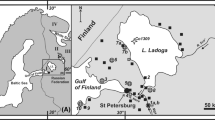Abstract
The micropaleontological study of two sediment cores taken from the continental slope of the Eastern Kamchatka Peninsula and from the northern Shirshov Ridge in the Bering Sea in the scope of the international KALMAR project reveals regional environmental changes over the last 20 kyr: the end of the last glaciation 20–15 ka, Bølling-Allerød warming 15.0–13.3 ka, the Younger Dryas cooling 13.3-11.9 ka, and the Early Holocene 11.9–5.0 ka. The most drastic paleoclimatic changes occurred at the transition from the last glacial period to the Holocene, which had different consequences in these two neighboring areas of the northwestern Pacific. The Bølling-Allerød warming episode resulted in the formation of a high- productivity marginal ice zone over the Shirshov Ridge and open-ocean conditions near eastern Kamchatka with the dominant influence of Alaskan water masses. The Younger Dryas cooling event in the continental slope area of Kamchatka was likely the most significant over the last 20 kyr: the neritic environments with a winter ice cover were dominant in this area at that time. The onset of the Holocene was probably marked by the formation of seasonally contrasting surface conditions in the northwestern corner of the open subarctic Pacific, which is evident from features indicating winter sea ice development and penetration of south-boreal water masses.
Similar content being viewed by others
References
Yu. B. Gladenkov, Stratigraphy of Marine Neogene of the North Pacific Belt (Nauka, Moscow, 1988) [in Russian].
A. P. Zhuze, Stratigraphic and Paleogeographic Studies of the Northwestern Pacific (Academy of Sciences of USSR, Moscow, 1962) [in Russian].
A. P. Zhuze, V. V. Mukhina, and O. G. Kozlova, “Diatoms and silicoflagellates in surface layer of sediments of the Pacific Ocean,” in Pacific Ocean: Microflora and Microfauna in Modern Sediments of the Pacific Ocean (Nauka, Moscow, 1969), pp. 6–47.
M. A. Levitan, T. G. Kuzmina, I. A. Roshchina, et al., “Late Pleistocene sedimentation history of the Shirshov Ridge, Bering Sea,” Geochem. Int. 51(3), 173–204 (2013).
E. I. Polyakova, Arctic Seas of Eurasia in Cenozoic (Nauchnyi Mir, Moscow, 1997) [in Russian].
V. S. Pushkar’ and M. V. Cherepanova, Diatoms of Pliocene and Anthropogene of Northern Pacific: Stratigraphy and Paleoecology (Dal’nauka, Vladivostok, 2001) [in Russian].
I. B. Tsoi and V. V. Shastina, Cenozoic Silicate Microplankton from Sediments of the Sea of Okhotsk and Kurile-Kamchatka Through (Dal’nauka, Vladivostok, 2005) [in Russian].
F. Akiba and Y. Yanagizawa, “Taxonomy, morphology and phylogeny of the Neogene diatom zonal marker species in the middle-to-high latitudes of the North Pacific,” Initial Rep. Deep Sea Drill. Proj. 87, 483–554 (1986).
J. A. Barron, “Late Cenozoic diatom biostratigraphy and paleoceanography of the middle-latitude eastern North Pacific, Deep Sea Drilling Project Leg 63,” Initial Rep. Deep Sea Drill. Proj. 63, 507–538 (1981).
J. A. Barron, D. Bukry, W. E. Dean, et al., “Paleoceanography of the Gulf of Alaska during the past 15,000 years: Results from diatoms, silicoflagellates, and geochemistry,” Mar. Micropaleontol. 56, 81–102 (2009).
COHMAP Members, “Climatic changes of the last 18000 years: observations and model simulations,” Science 241, 1043–1052 (1988).
Cruise Report SO201-2 KALMAR, in IFM-GEOMAR Report, Ed. by W.-C. Dullo et al. (GEOMAR, 2009), No. 35.
M. E. Edwards, L. B. Brubaker, A. V. Lozhkin, and P. M. Anderson, “Structurally novel biomes: a response to past warming in Beringia,” Ecology 86, 1696–1703 (2005).
S. A. Gorbarenko, O. Y. Psheneva, A. V. Artemova, et al., “Paleoenvironment changes in the NW Okhotsk Sea for the last 18 kyr determined with micropaleontological, geochemical, and lithological data,” Deep-Sea Res., Part I 57, 797–811 (2010).
G. K. Kazarina and I. G. Yushina, “Diatoms in recent and Holocene sediments of the North Pacific and the Bering Sea,” Ber. Polarforschung. 306, 134–148 (1999).
I. Koizumi, “Late Neogene paleoceanography in the western North Pacific,” Initial Rep. Deep Sea Drill. Proj. 86, 429–438 (1985).
I. Koizumi, K. Shiga, T. Irino, and M. Ikehara, “Diatom record of the late Holocene in the Okhotsk Sea,” Mar. Micropaleontol. 49, 139–156 (2003).
L. Max, J.-R. Riethdorf, R. Tiedemann, et al., “Sea surface temperature variability and sea-ice extent in the subarctic Northwest Pacific during the past 15.000 years,” Paleoceanography 27, PA3213 (2012). doi: 10.1029/2012PA002292
NOAA’s Pacific Marine Environmental Laboratory. http://www.pmel.noaa.gov
D. Nürnberg and R. Tiedemann, “Environmental change in the Sea of Okhotsk during the last 1.1 million years,” Paleoceanography 19, PA4011 (2004). doi:10.1029/2004PA001023
J. Ren, R. Gersonde, O. Esper, and C. Sancetta, “Diatom distributions in northern North Pacific surface sediments and their relationship to modern environmental variables,” Palaeogeogr., Palaeoclimatol., Palaeoecol. 402, 81–103 (2014).
J.-R. Riethdorf, L. Max, D. Nürnberg, et al., “Deglacial development of (sub) sea surface temperature and salinity in the subarctic northwest Pacific: Implications for upper-ocean stratification,” Paleoceanography 28, 91–104 (2013).
K. Takahashi, N. Fujitani, M. Yanada, and Y. Maita, “Long-term biogenic particle fluxes in the Bering Sea and the central subarctic Pacific Ocean, 1990-1995,” Deep-Sea Res., Part I 47, 1723–1759 (2000).
C. Sancetta, “Oceanographic and ecologic significance of diatoms in surface sediments of the Bering and Okhotsk seas,” Deep-Sea Res., Part A 28(8), 789–817 (1981).
C. Sancetta and S. W. Robinson, “Diatom evidence on Wisconsin and Holocene events in the Bering Sea,” Quat. Res. 20(2), 232–245 (1983).
C. Sancetta and S. M. Silvestri, “Pliocene-Pleistocene evolution of the North Pacific ocean-atmosphere system, interpreted from fossil diatoms,” Paleoceanography 1, 163–180 (1986).
H. J. Schrader, “Cenozoic diatoms from the northeast Pacific, Leg 18,” Initial Rep. Deep Sea Drill. Proj. 18, 673–797 (1973).
M. Uda, “Oceanography of the subarctic Pacific Ocean,” J. Fish. Res. Board Can. 20(1), 119–179 (1963).
Author information
Authors and Affiliations
Corresponding author
Additional information
Original Russian Text © M.A. Smirnova, G.Kh. Kazarina, A.G. Matul, L. Max, 2015, published in Okeanologiya, 2015, Vol. 55, No. 3, pp. 425–431.
Rights and permissions
About this article
Cite this article
Smirnova, M.A., Kazarina, G.K., Matul, A.G. et al. Diatom evidence for paleoclimate changes in the northwestern Pacific during the last 20000 years. Oceanology 55, 383–389 (2015). https://doi.org/10.1134/S0001437015030157
Received:
Accepted:
Published:
Issue Date:
DOI: https://doi.org/10.1134/S0001437015030157



